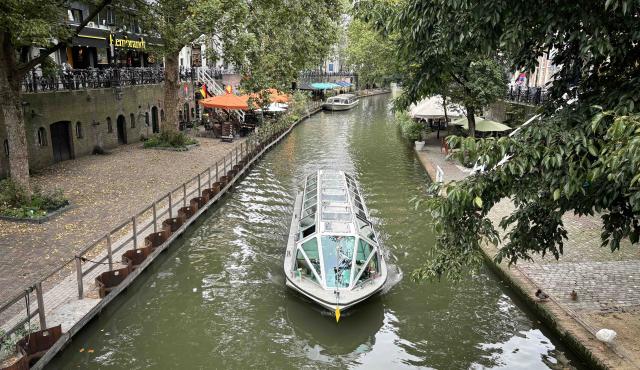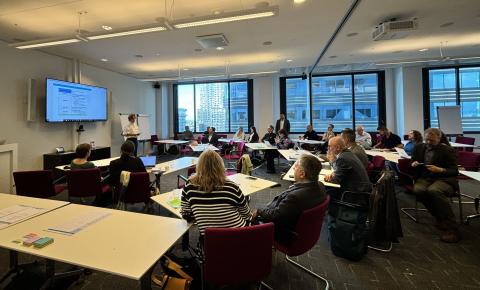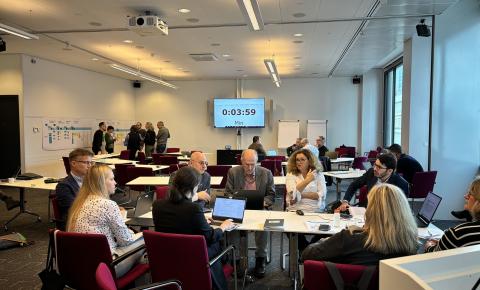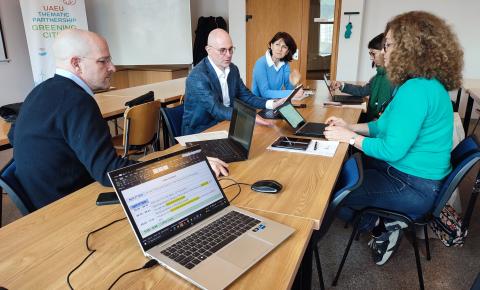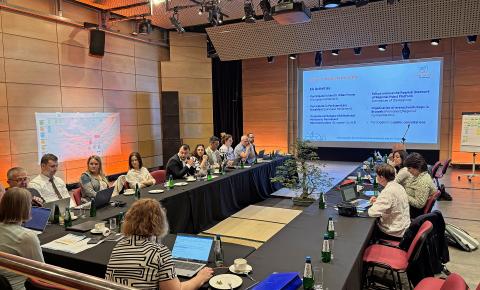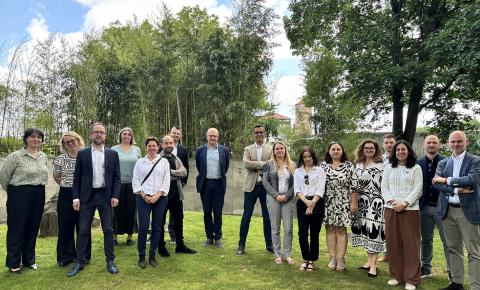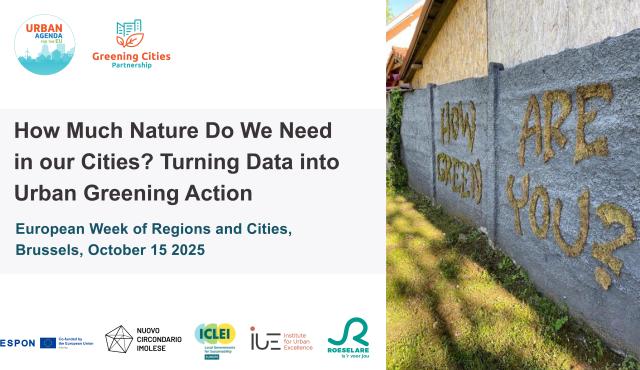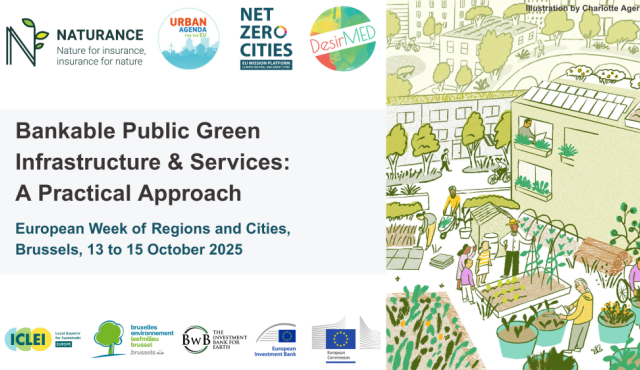News
About the partnership
Launched in December 2022 as part of the Urban Agenda for the EU, the Greening Cities Partnership brings together 31 members, including 10 cities, 2 regions, and 3 national authorities, to address the pressing challenges of urban green infrastructure. Our mission is to enhance urban biodiversity, combat climate change, and improve citizens' well-being by promoting sustainable green spaces and nature-based solutions in urban areas.
The Partnership aligns with the broader objectives of cities to create cleaner air, more inclusive urban environments, and aesthetic public spaces. By working across local, regional, national, and EU governance levels, the Partnership aims to contribute to the development and implementation of policies that support green infrastructure and the Nature Restoration Law, particularly Article 8.
Thematic focus
The Greening Cities Partnership operates through four dedicated working groups (WGs), each focused on critical aspects of urban greening and aligned with the Partnership’s mission to strengthen green infrastructure across European cities. The Partnership’s thematic focus is rooted in the following core areas, which reflect the most pressing needs of cities in terms of urban biodiversity, climate adaptation, and nature-based solutions, and address the three UAEU pillars: Better Knowledge, Better Funding, and Better Regulation.
TOPIC 1 – Methodology for Quantifying the Demand for Green Infrastructure at Local Level
The need for green infrastructure is often unevenly understood or quantified across European cities. This WG aims to develop a robust methodology for assessing the demand for GI, helping cities identify where and how to implement green spaces most effectively. The methodology will support evidence-based urban planning and policy decisions for enhancing biodiversity, climate adaptation, and community well-being.
TOPIC 2 – Indicator System for Urban Nature Restoration
This WG is focused on creating a comprehensive system of indicators to monitor progress in urban greening and the implementation of Urban Nature Plans (UNPs). The indicators system will provide cities with tools to measure and assess their progress toward biodiversity, climate adaptation, and ecosystem restoration goals.
TOPIC 3 – Policies for achieving urban restoration targets
The WG on Urban Nature Plans focuses on providing cities with practical guidance on implementing the Nature Restoration Regulation’s urban ecosystem targets. By integrating these plans into local governance structures, cities will be better equipped to achieve biodiversity, climate adaptation, and liveability goals. The WG will highlight best practices, innovative approaches, and case studies to support cities in overcoming challenges related to land use, community engagement, and governance.
TOPIC 4 – Funding for Green Infrastructure
This theme addresses the need for innovative and accessible financing mechanisms to support urban authorities in greening their cities. The WG on Funding focuses on developing strategies to enhance the availability and access to EU funding sources for urban green infrastructure (GI), while also exploring public-private partnerships and alternative financing models to ensure long-term investment and maintenance of GI projects.
The need for green infrastructure is often unevenly understood or quantified across European cities. This WG aims to develop a robust methodology for assessing the demand for GI, helping cities identify where and how to implement green spaces most effectively. The methodology will support evidence-based urban planning and policy decisions for enhancing biodiversity, climate adaptation, and community well-being.
This WG is focused on creating a comprehensive system of indicators to monitor progress in urban greening and the implementation of Urban Nature Plans (UNPs). The indicators system will provide cities with tools to measure and assess their progress toward biodiversity, climate adaptation, and ecosystem restoration goals.
The WG on Urban Nature Plans focuses on providing cities with practical guidance on implementing the Nature Restoration Regulation’s urban ecosystem targets. By integrating these plans into local governance structures, cities will be better equipped to achieve biodiversity, climate adaptation, and liveability goals. The WG will highlight best practices, innovative approaches, and case studies to support cities in overcoming challenges related to land use, community engagement, and governance.
This theme addresses the need for innovative and accessible financing mechanisms to support urban authorities in greening their cities. The WG on Funding focuses on developing strategies to enhance the availability and access to EU funding sources for urban green infrastructure (GI), while also exploring public-private partnerships and alternative financing models to ensure long-term investment and maintenance of GI projects.
We invite you to explore the Miro-board embedded below to view the Greening Cities Action Plan at a glance
Members
By clicking on the symbol , in the top left corner, you will be able to see the different layers of this map.
National authorities
- Ministry of Development, Public Works and Administration, Coordinator (RO)
- Ministry of Physical Planning, Construction and State Assets (HR)
- Ministry of Development Funds and Regional Policy of the Republic of Poland (PL)
Regions
- Brussels Environment (BE)
- Flemish Environment Agency (BE) – [Active until December 2023]
- Marshal’s Office of the Mazowieckie Voivodeship (PL)
Cities (Urban Authorities)
- Nuovo Circondario Imolese, Coordinator (IT)
- Roma Capitale (IT)
- City of 's-Hertogenbosch, Department of Urban Development (NL)
- City of Utrecht (NL)
- City of Tampere (FI)
- City of Ostrava (CZ)
- City of Roeselare (BE) – [Active from December 2023]
- Municipality of Ādaži (LV)
- City Council of Pontevedra (Ayuntamiento de Pontevedra) (ES)
- Lisbon Metropolitan Area (PT)
European/ national city umbrella organisation
- Eurocities (BE)
- European Investment Bank (EIB)
- Association of Urban Municipalities of Slovenia (SI)
- European Urban Knowledge Network (EUKN EGTC) (NL)
- ICLEI European Secretariat (DE) – [Active from January 2025]
Other stakeholders
- Catalan Land Institute (INCASÒL) (ES)
- Aristotle University of Thessaloniki (AUTH) / Environmental Engineering Laboratory (Enve-Lab) (GR)
- JPI Urban Europe / DUT Partnership
European institution
- European Commission Directorate-General for Regional and Urban Policy (DG REGIO)
- European Commission Directorate-General for Environment (DG ENV)
- European Commission Directorate-General for Employment, social affairs and inclusion (DG EMPL)
- European Commission Directorate-General for Internal Market, Industry, Entrepreneurship and SMEs (DG GROW)
- European Commission Directorate-General for Climate Action (DG CLIMA)
- European Commission Directorate-General for Maritime Affairs and Fisheries (DG MARE)
- European Commission DG Directorate-General for Education, Youth, Sport and Culture (DG EAC)
- European Commission Directorate-General for Agriculture and Rural Development (DG AGRI)
- European Commission Joint Research Centre (JRC)
Documents
EUI - Call for City-to-City Exchanges
The call for City-to-City exchanges is open on a continous basis.
Check the details and apply to benefit of other city experiences to tackle your sustainable urban development challenges.
Knowledge
View knowledge outputs on Portico
Portico is the European urban knowledge platform developed by the European Urban Initiative (EUI) in support of better urban policy and strategy design, implementation, and mainstreaming.
Updated on 2 years 3 months ago
